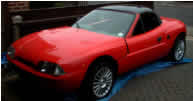The Minari was designed by Andy Borrowman and Sean Prendergast
of Minari Engineering Ltd, to accept Alfasud running gear, engine and transmission.
A rigid GRP monocoque body carries a steel subframe which, along with the donor’s
front crossmember, supports the engine. The prototype was extensively tested
over 20,000 miles of rough and smooth roads and tracks without any problem.
In fact it continued in service through the 140,000 mile mark.
With a height of 1090mm, width 1580mm and length 3480mm, the roadster was shorter
and lower than the 'Sud, with a 220mm shorter wheelbase. The light weight (around
720kg) and low centre of gravity, gave handling and performance which exceeded
the high standards of the 'Sud. Top speeds around of 120 mph, and 0-60 times
well below 9 sec are seen with the 1500 twin carb engine, with better performance
possible from 8 and 16 valve 1700 engines.
| After launch in 1990,
around twelve Mk1 (ClubSport) kits were sold. The Register knows of only
4 of these. The car had generous behind seat stowage and a good sized boot.
Weather protection was provided by a hood and clip- in side screens. Access
to the engine was better than in the donor car with a swing forward front
end. |
 |
 |
Having proved the concept,
a Mk2 (RoadSport) version was produced. This had shallower sills, wind-up
windows, remodelled front and rear ends, but a smaller boot due to addition
of an extra stiffening bulkhead around the rear suspension. Hood and hardtop
were available. The first Mk2s were aimed at 'Sud donors, the Alfa 33 was
the basis for later kits. Around 130 Mk2 kits were sold before production
finally stopped in 2000. Of these about 70 are known to the Register. |
A few Mk2 RSRs were produced. These
had no screen and the option of a lightweight carbon fibre body (see On
the Track).
Many cars were built or part-built by Chameleon Cars, who were sales agents
for the Minari during the late '90s.
|
 |



